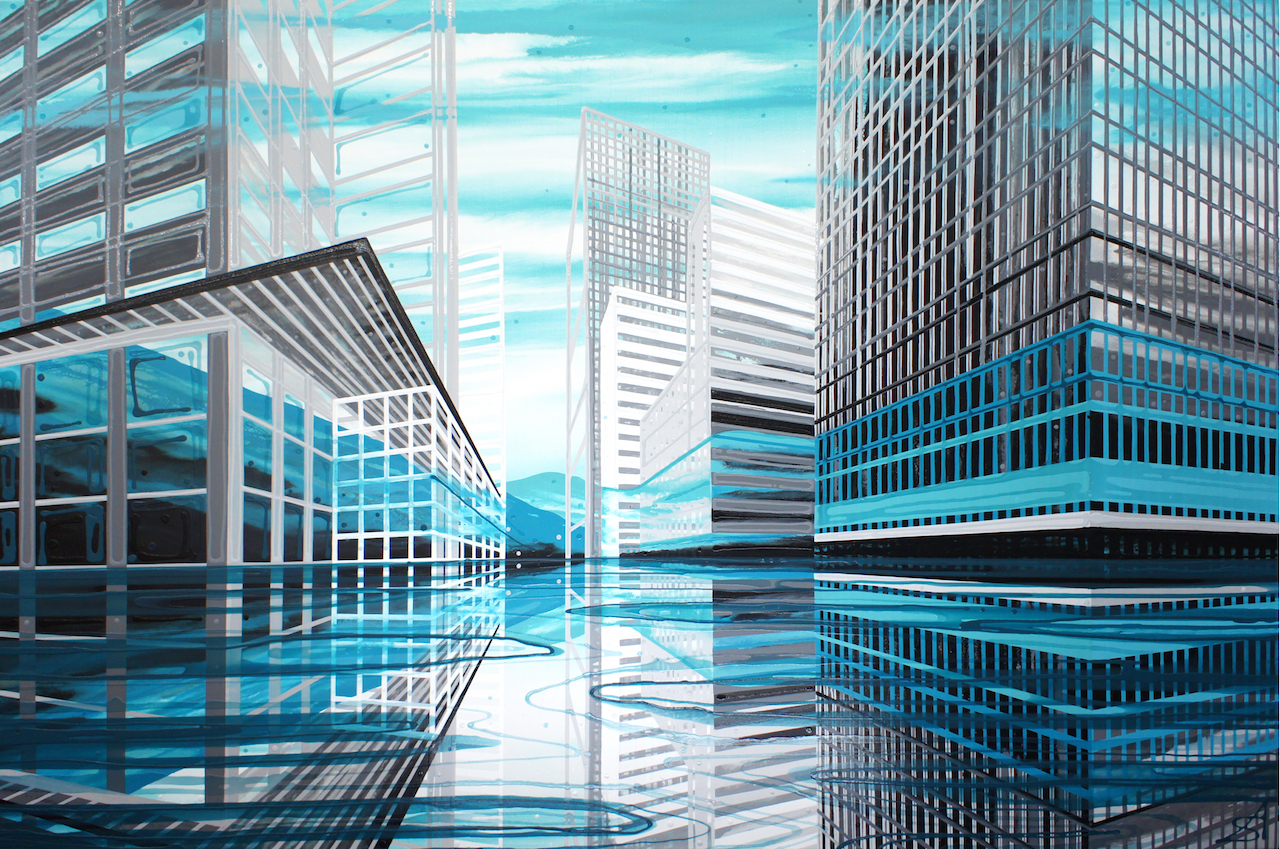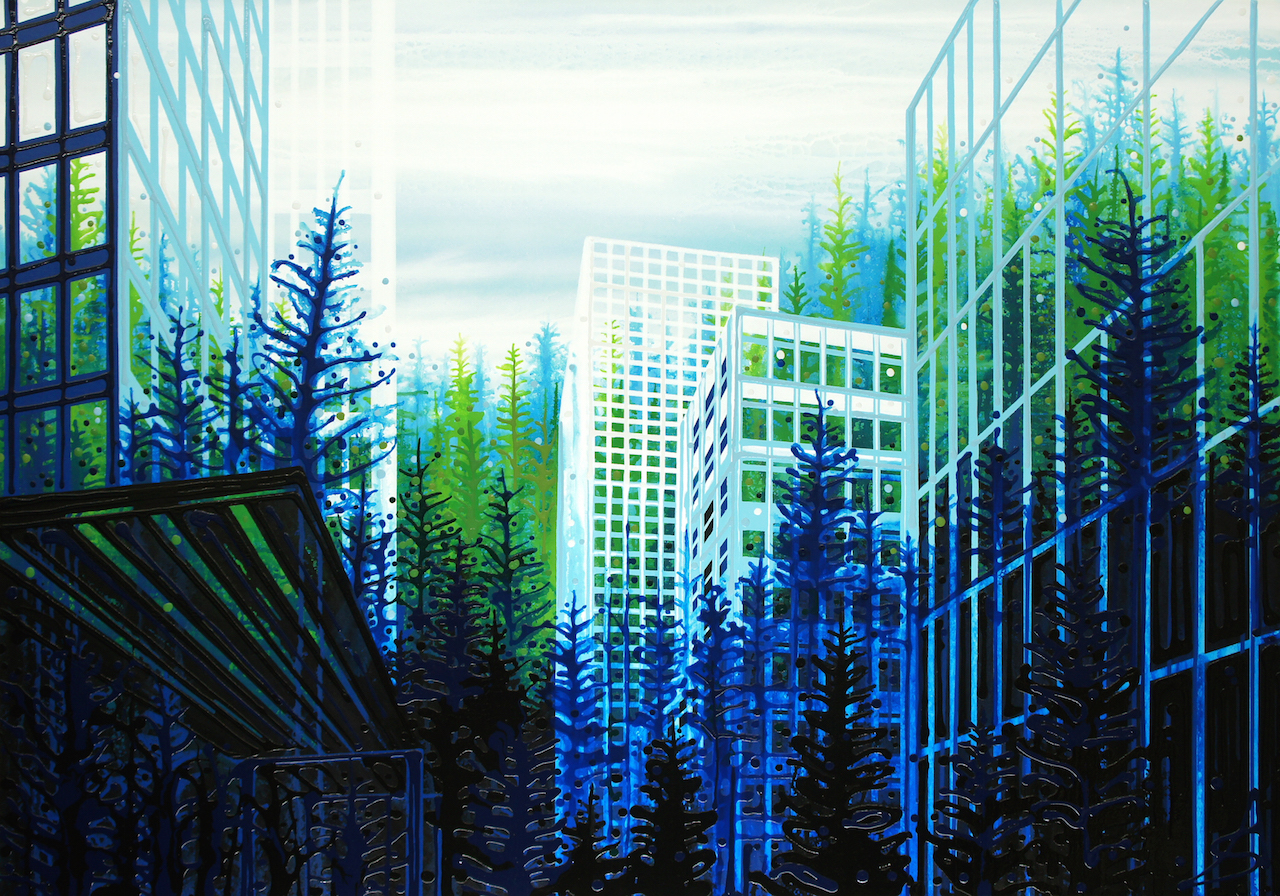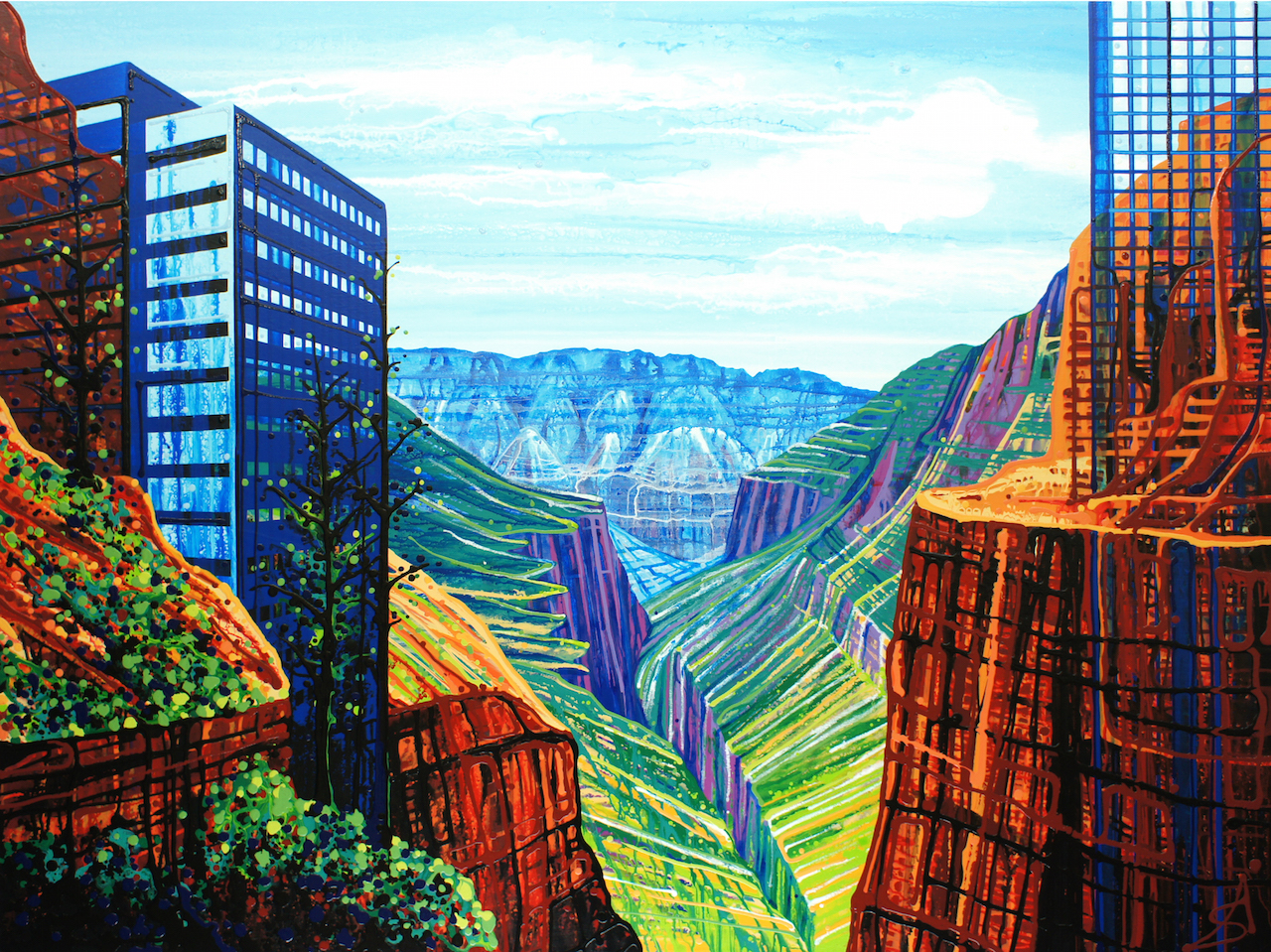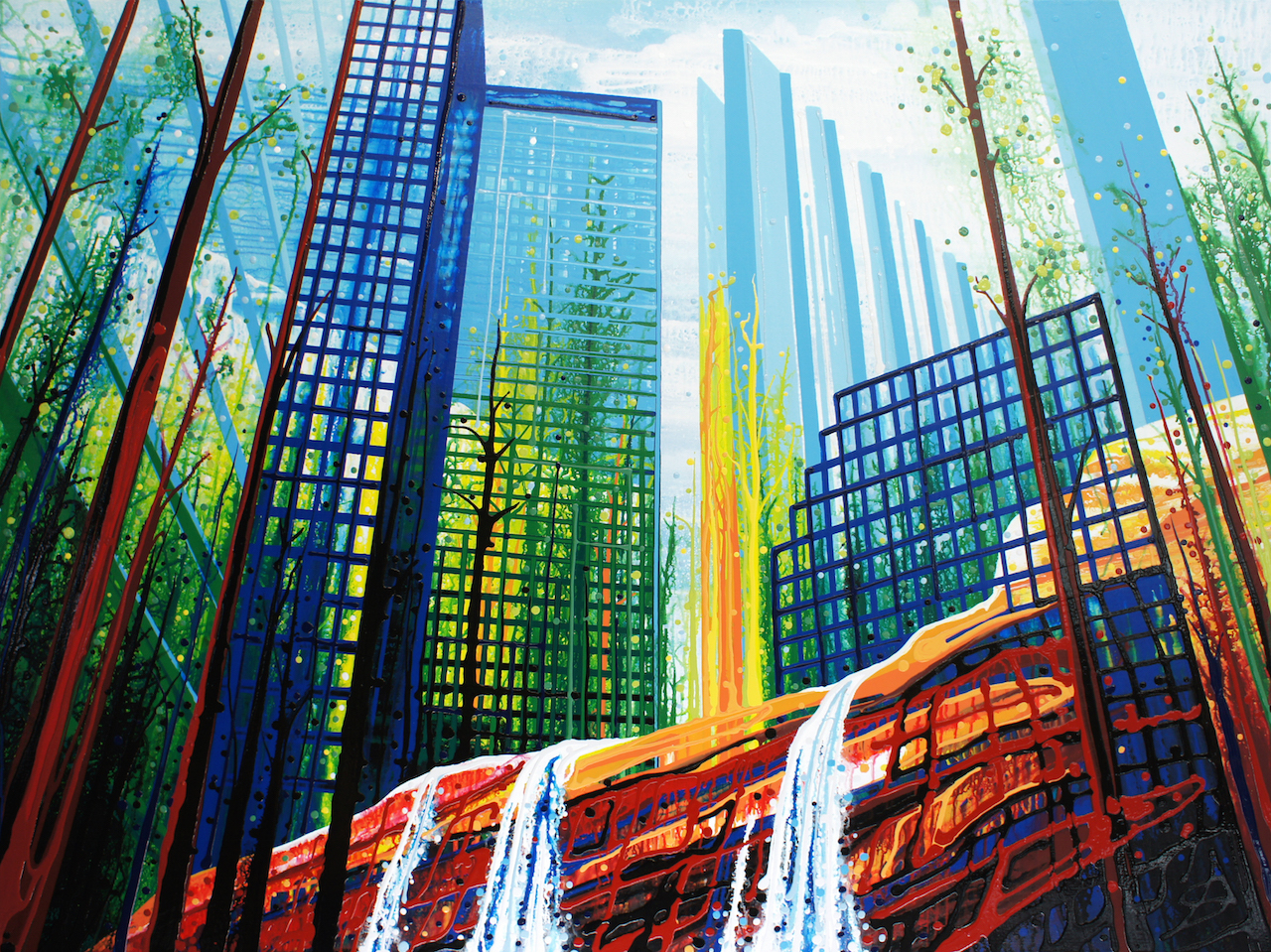 Amy Shackleton in front of her easel. Photo: Julian Brown
Amy Shackleton in front of her easel. Photo: Julian Brown
Interview with Amy Shackleton (AS) by Emese Krunák-Hajagos (EKH)
EKH: When visiting your exhibition at the Elaine Fleck Gallery in Toronto, I was looking at your large format paintings trying to figure out the technique you used. Then Elaine Fleck explained that it is a unique process, invented by you, called Gravity paintings, since you use gravity to control the flow of paint. When and how did you discover and develop your painting method?
AS: I’ve been shaping my painting method into something unique, that I enjoy for years. I first learnt how to paint with paintbrushes, but it took me longer to discover how to paint without them! It wasn’t easy to stop using the tool I was most comfortable with, but you have to take risks to discover new things.
I started using drips back in 2008 to achieve a natural/organic energy in my work. At that time I used paintbrushes and tape to create the more concrete, architectural elements. As I became more experienced with using gravity to direct the flow of paint, the paintbrush became an unnecessary touch-up tool. It was then I realized with more planning, calculating and layering I could eliminate the use of a paintbrush and tape. This became a challenge that took over three years to master. In 2011 I created my first brushless painting. Now, after years of experimenting with gravity and rotating my canvas, I am able to manipulate where and how each drip will fall. My work evolves with each piece I create. I am still discovering new techniques.
 Amy Shackleton, Above Water (New York + Yukon) 2015, acrylic and enamel on canvas, 60″ x 90″. Image courtesy of the artist and Elaine Fleck Gallery
Amy Shackleton, Above Water (New York + Yukon) 2015, acrylic and enamel on canvas, 60″ x 90″. Image courtesy of the artist and Elaine Fleck Gallery
EKH: I also watched the amazing videos, Terraced city and Waterworks (Painting Time-Lapse) showing you during work. You don’t use paintbrush but a special technique that never been used before. Please tell us more about the details of the procedure.
AS: Using squeeze bottles filled with liquid paint I build each painting from the ground up with hundreds of lines and dots. I use string and a level to help predict where each drip will fall and a spray bottle filled with water to manipulate the drips. As in real life construction, the architectural aspects of my work are calculated, measured and controlled in order to assure precise locations of each line. As in nature, the environmental elements are more spontaneous, liquid and organic, relying on gravity’s force.
EKH: Many of your works are large. How is a 50-foot long piece assembled?
AS: My studio is set up to accommodate the creation of large scale works. The maximum diameter I can spin is fourteen feet, but I am able to create larger pieces by using multiple panels. I am currently working on a 53-foot-long piece, which is made up of thirteen interconnected panels. Since my spinning/drip technique requires drying time between layers, I make the best use of my time by working on up to six paintings at once in my studio.
 Amy Shackleton,Through the Trees (Toronto + California) 2015, acrylic and enamel on canvas, 45” x 60”. Image courtesy of the artist and Elaine Fleck Gallery
Amy Shackleton,Through the Trees (Toronto + California) 2015, acrylic and enamel on canvas, 45” x 60”. Image courtesy of the artist and Elaine Fleck Gallery
EKH: The subject matter of your canvases are mainly urban landscapes. Did you find your theme first and then develop a suitable painting method for it, or was it in the other way around?
AS: I discovered my theme before I developed a suitable painting method for it. After experimenting with a variety of subjects, I eventually zoned in on urban landscapes because I have a passion for nature and the city. I have always had a soft spot for nature, but my attraction to the city came much later—during my studies at York University in Toronto. That is when I began to realize the environmental benefits of high-density living and I started exploring the relationship between nature and cities.
I explored this theme and experimented with various techniques during my studies at York University. My unique painting method began to emerge in my fourth year and has been evolving ever since.
 Amy Shackleton, Recover (New York + Vancouver) 2016, acrylic and enamel on canvas, 35″ x 50″. Image courtesy of the artist and Elaine Fleck Gallery
Amy Shackleton, Recover (New York + Vancouver) 2016, acrylic and enamel on canvas, 35″ x 50″. Image courtesy of the artist and Elaine Fleck Gallery
EKH: Your paintings are mostly realistic cityscapes with elements of abstraction depicted with strong colors. They seem calculated, almost architecturally planned, but still feel somewhat spontaneous. How do you decide on a composition? Do you work from photographs or sketches?
AS: Yes! I’m glad you feel the spontaneity amidst the planned elements of my work. Since I like to experience the places I paint, I travel for inspiration. I take thousands of photographs of urban and natural environments to inspire my digital studies. I use Photoshop to juxtapose my photographs, develop a composition and decide on a colour palette. Once I know exactly where I’m going with the piece I print the computer study and start painting. Since each layer builds on the last, there is little room for error with my technique.
 Amy Shackleton, Perched on the Rim (Arizona + Toronto) 2014, acrylic and enamel on canvas, 45″ x 60″. Image courtesy of the artist and Elaine Fleck Gallery
Amy Shackleton, Perched on the Rim (Arizona + Toronto) 2014, acrylic and enamel on canvas, 45″ x 60″. Image courtesy of the artist and Elaine Fleck Gallery
EKH: The introduction for your exhibition at Elaine Fleck Gallery states: “Shackleton’s paintings call to mind the dystopian post-apocalyptic aesthetic but strangely without all the gloom, hinting at rebirth and optimism.” You aim for a new, harmonious synthesis of the urban and the natural world. Do you consider yourself an environmentalist?
AS: I do consider myself an environmentalist. My paintings are intended to portray urban life at its best, demonstrating ways we can work with nature rather than against it. I envision post-industrial worlds where sustainable relationships exist between man and the environment. By exploring the continually evolving approaches to preserving our environment and living more efficiently, I suggest how we can implement innovative solutions for city planning and development with minimal impact on surrounding habitats.
 Amy Shackleton, Building Blocks (Toronto + Yosemite National Park) 2014, acrylic and enamel on canvas, 45″ x 60″. Image courtesy of the artist and Elaine Fleck Gallery
Amy Shackleton, Building Blocks (Toronto + Yosemite National Park) 2014, acrylic and enamel on canvas, 45″ x 60″. Image courtesy of the artist and Elaine Fleck Gallery
EKH: What is coming up for you in the near future?
AS: The Elaine Fleck Gallery will be hosting a solo exhibition of my work this December. Together with the Elaine Fleck Gallery, I am planning a Canada-wide exhibition of my 53-foot-long painting in progress: The Great Canadian LEEDscape. Featuring imagery from each province and territory, this painting explores the natural environment and the recent development of sustainable, LEED-certified buildings from coast to coast. The exhibition is scheduled to debut at Evergreen Brick Works in May 2017 followed by the Visual Arts Centre of Clarington in June 2017. We are in the process of securing additional venues in Western, Northern and Atlantic Canada.
